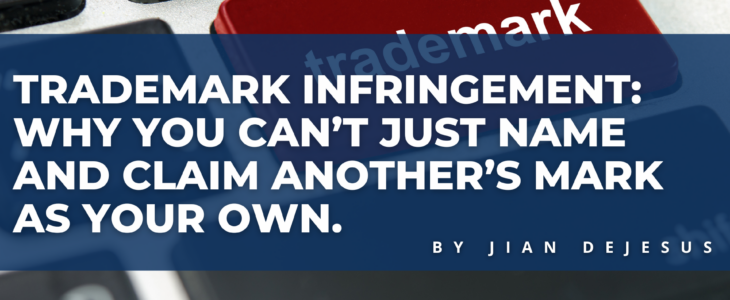What is a “trademark”?
Have you ever noticed the “™” or “®” symbol next to the names of your favorite brands and wondered what those symbols meant? Those symbols indicate an individual’s or entity’s trademark, which is a type of intellectual property that identifies the source of origin of certain goods and/or services in commerce. Trademarks are useful to protect a brand and to distinguish the owner from competitors in the market.
The Lanham Act
The Lanham Act includes the statutes that provide “for a national system of trademark registration and protect[ions]” for federally-registered trademark owners. 1Under the Lanham Act, a “trademark” is defined as “any word, name, symbol, or device, or any combination thereof (1) used by a person” in commerce, or (2) in “which a person has a bona fide intention to use” the mark “in commerce and applies to register” the mark.2 Trademarks are thereby associated with “specific goods or services sold to customers.”3 For example, The Coca-Cola Company owns various federally-registered trademarks, including the mark “Coca-Cola” that allows the company to use the mark to sell its beverage products, among other goods, in commercial markets.4
Exclusive Rights Afforded to Trademark Owners
Owning a trademark affords its owners protection from others who seek to register and/or use the same or similar mark as the owner “with related goods or services” in commerce.5 Federal registration provides owners with “nationwide legal protection . . . in connection with particular goods or services.”6 Therefore, owning a trademark helps consumers identify the source of the goods and/or services, provides owners with legal protection of its brand, and helps owners “guard against counterfeiting and fraud.”7
Federal Registration vs. Unregistered Marks
Registering a trademark with the United States Patent and Trademark Office (“USPTO”) affords a trademark owner with nationally enforceable rights and the privilege of having its registered trademark accessible in the USPTO’s public database.8 Federal registration further allows for a trademark owner to utilize the “®” symbol in its marks and to “generally rely on those rights to protect” the use of the trademark as the trademark owner expands its “business across state lines.”9 While the USPTO affords such rights to registered trademarks, the trademark owner still bears the responsibility to enforce its rights by pursuing infringers of its mark.10
On the other hand, an unregistered mark provides owners with “common law rights,” which “are based on use of the trademark in commerce within a particular geographic area.”11 Therefore, unlike federally registered trademarks that afford protection throughout the United States, unregistered marks may only have enforceable “rights in the specific areas in the United States where” the trademark is used.12
How do I know if I am infringing an existing trademark?
Trademark infringement occurs when an infringer uses a trademark without authorization or consent from the owner, “in connection with goods and/or services . . . that is likely to cause confusion, deception, or mistake about the source of the goods and/or services.”13 In determining infringement, the focus is on the consumer’s perception—will the consumer confuse the infringer’s mark as that of the owner’s mark and will therefore purchase from the infringer’s goods and/or services instead of the owner’s products?
What must the trademark owner prove?
In determining trademark infringement, the (1) “plaintiff must prove that it owns a valid mark”; (2) has priority in the mark over the defendant (e.g., if the plaintiff is the first to use the mark in commerce before the defendant, then the plaintiff would be considered a senior user); and (3) “the defendant’s mark is likely to cause confusion in the minds of consumers about the source or sponsorship of the goods or services” that is associated with the mark.14
Likelihood of Confusion
In In re E.I. Du Pont de Nemours & Co., a 1973 case before the United States Court of Customs and Patent Appeals, the Court established a set of factors useful for analyzing and assessing the “likelihood of confusion” between trademarks. This set of factors, also known as the Du Pont factors, have been useful to the USPTO in reviewing trademark applications and to the courts in determining infringement. The Du Pont factors are as follows:
- The similarity or dissimilarity of the marks in their entireties as to appearance, sound, connotation and commercial impression.
- The similarity or dissimilarity and nature of the goods or services as described in an application or registration or in connection with which a prior mark is in use.
- The similarity or dissimilarity of established, likely-to-continue trade channels.
- The conditions under which and buyers to whom sales are made, i.e. “impulse” vs. careful, sophisticated purchasing.
- The fame of the prior mark (sales, advertising, length of use).
- The number and nature of similar marks in use on similar goods.
- The nature and extent of any actual confusion.
- The length of time during and conditions under which there has been concurrent use without evidence of actual confusion.
- The variety of goods on which a mark is or is not used (house mark, “family” mark, product mark).
- The market interface between applicant and the owner of a prior mark:
- a mere “consent” to register or use.
- agreement provisions designed to preclude confusion, i.e. limitations on continued use of the marks by each party.
- assignment of mark, application, registration and good will of the related business.
- laches and estoppel attributable to owner of prior mark and indicative of lack of confusion.
- The extent to which applicant has a right to exclude others from use of its mark on its goods.
- The extent of potential confusion, i.e., whether de minimis or substantial.
- Any other established facts probative of the effect of use.
In re E.I. Du Pont de Nemours & Co., 476 F.2d 1357, 1361, 177 USPQ 563, 567 (CCPA 1973). The Du Pont factors consider the consumer perspective between the marks and the goods and/or services associated with each mark. Therefore, even if the marks are not necessarily “identical,” if the marks are likely to cause confusion among consumers, then the marks may nonetheless be conflicting to one another.
While there are thirteen Du Pont factors that the USPTO and courts weigh, these three tend to be the primary factors considered: (1) similarity of the marks as to sound, appearance, connotation, and commercial impression; (2) similarity of the goods and/or services associated with the marks; and (3) similarity of the trade channels by which the goods and/or services are distributed.
Contact Sul Lee Law Firm Today
Navigating trademark rights and potential infringement requires a deep understanding of the law. If you need assistance with experienced trademark lawyers, contact Sul Lee Law for an appointment today. Our attorneys are ready to provide valuable insights and discuss your trademark matters with you.
- Lanham Act, Cornell L. Sch., https://www.law.cornell.edu/wex/lanham_act#:~:text=The%20Lanham%20Act%2C%2015%20U.S.C.%20%C2%A7%C2%A7%201051%20et,of%20a%20famous%20mark%20is%20likely%20to%20occur (last visited July 9, 2024). ↩︎
- 15 U.S.C. § 1127. ↩︎
- Trademark scope of protection, U.S. Trademark & Patent Off., https://www.uspto.gov/trademarks/basics/scope-protection (last visited July 8, 2024). ↩︎
- See, e.g., Trademark Status & Document Retrieval (COCA-COLA), https://tsdr.uspto.gov/#caseNumber=73601167&caseSearchType=US_APPLICATION&caseType=DEFAULT&searchType=statusSearch (last visited July 9, 2024). ↩︎
- Trademark, patent, or copyright, U.S. Trademark & Patent Off., https://www.uspto.gov/trademarks/basics/trademark-patent-copyright (last visited July 8, 2024). ↩︎
- Id. ↩︎
- What is a trademark?, U.S. Trademark & Patent Off., https://www.uspto.gov/trademarks/basics/what-trademark (July 8, 2024). ↩︎
- What register your trademark?, U.S. Trademark & Patent Off., https://www.uspto.gov/trademarks/basics/why-register-your-trademark (last visited July 8, 2024). ↩︎
- Id. ↩︎
- See id. ↩︎
- Id. ↩︎
- Id. ↩︎
- About Trademark Infringement, U.S. Trademark & Patent Off., https://www.uspto.gov/page/about-trademark-infringement (last visited July 5, 2024). ↩︎
- Id. ↩︎

